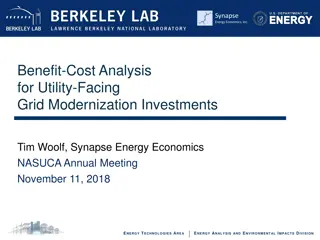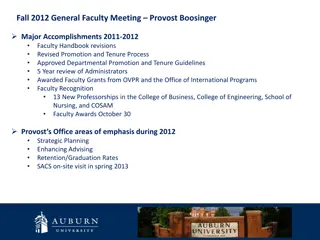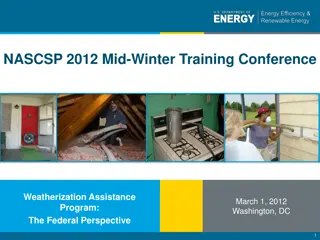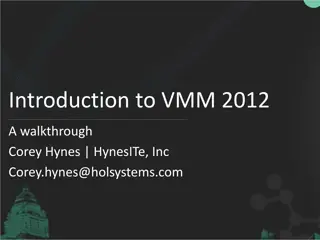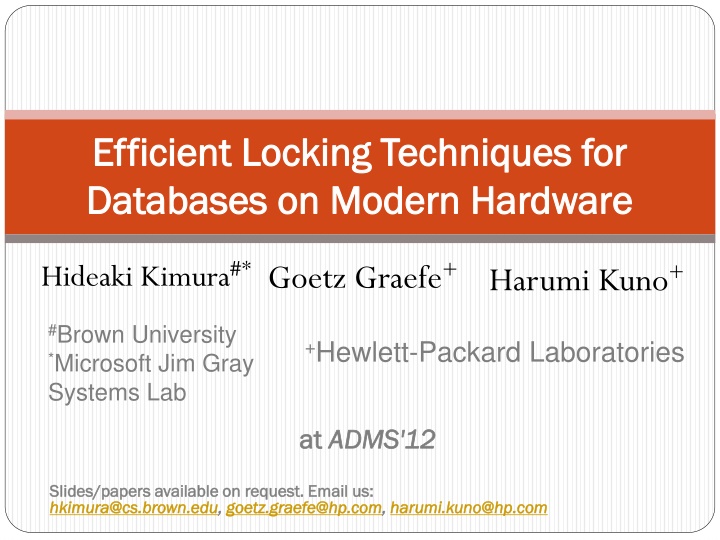
Efficient Locking Techniques for Databases on Modern Hardware - Overview
Explore efficient locking techniques for databases on modern hardware, including key range locks, lightweight intent locks, scalable deadlock detection, and more. Learn about key advancements in database locking mechanisms to enhance performance and concurrency.
Download Presentation

Please find below an Image/Link to download the presentation.
The content on the website is provided AS IS for your information and personal use only. It may not be sold, licensed, or shared on other websites without obtaining consent from the author. If you encounter any issues during the download, it is possible that the publisher has removed the file from their server.
You are allowed to download the files provided on this website for personal or commercial use, subject to the condition that they are used lawfully. All files are the property of their respective owners.
The content on the website is provided AS IS for your information and personal use only. It may not be sold, licensed, or shared on other websites without obtaining consent from the author.
E N D
Presentation Transcript
Efficient Locking Techniques for Efficient Locking Techniques for Databases on Modern Hardware Databases on Modern Hardware Hideaki Kimura#* Goetz Graefe+ Harumi Kuno+ #Brown University *Microsoft Jim Gray Systems Lab +Hewlett-Packard Laboratories a at t ADMS'12 ADMS'12 Slides/papers available on request. Email us: Slides/papers available on request. Email us: hkimura@cs.brown.edu hkimura@cs.brown.edu, , goetz.graefe@hp.com goetz.graefe@hp.com, , harumi.kuno@hp.com harumi.kuno@hp.com
Traditional DBMS on Modern Hardware Traditional DBMS on Modern Hardware Optimized for Magnetic Disk Bottleneck Query Execution Overhead Disk I/O Costs Then What s This? Other Costs Useful Work Fig. Instructions and Cycles for New Order [S. Harizopoulos et al. SIGMOD 08] 2/26
Context of This Context of This P Paper aper Achieved up to 6x overall speed-up Foster B-trees Consolidation Array, Flush-Pipeline Shore-MT/Aether [Johnson et al'10] This Paper Work in progress 3/26
Our Prior Work: Foster B Our Prior Work: Foster B- -trees trees [TODS'12] Foster Relationship Fence Keys Simple Prefix Compression Poor-man's Normalized Keys Efficient yet Exhaustive Verification Implemented by modifying Shore-MT and compared with it: Low Latch Contention 2-3x speed-up High Latch Contention 6x speedup On Sun Niagara. Tested without locks. only latches. 4/26
Talk Overview Talk Overview Key Range Locks w/ Higher Concurrency Combines fence-keys and Graefe lock modes 2) Lightweight Intent Lock Extremely Scalable and Fast 3) Scalable Deadlock Detection Dreadlocks Algorithm applied to Databases 4) Serializable Early-Lock-Release Serializable all-kinds ELR that allows read-only transaction to bypass logging 1) 5/26
1. Key 1. Key R Range Lock ange Lock SELECT Key=10 S UPDATE Key=30 Gap X 10 20 30 SELECT Key=20~25 SELECT Key=15 Mohan et al. : Locks neighboring key. Lomet et al.: Adds a few new lock modes. (e.g., RangeX-S) Still lacks a few lock modes, resulting in lower concurrency. 6/26
Our Key Range Locking Our Key Range Locking Graefe Lock Modes. All 3*3=9 modes Fence Keys E F E A E B E D E Z Use Fence Keys to lock on page boundary Create a ghost record (pseudo deleted record) before insertion as a separate Xct. 7/26
2. Intent Lock 2. Intent Lock [Gray et al] Coarse level locking (e.g., table, database) Intent Lock (IS/IX) and Absolute Lock (X/S/SIX) Saves overhead for large scan/write transactions (just one absolute lock) 8/26
Intent Lock: Physical Contention Intent Lock: Physical Contention Logical Physical Lock Queues DB-1 IS IX IS IX DB-1 VOL-1 IS VOL-1 IX IS IX IND-1 IS IS IX IND-1 IX Key-A S S Key-A Key-B X Key-B X 9/26
Lightweight Intent Lock Lightweight Intent Lock Logical Physical DB-1 IS IX IS IX 1 1 1 S 0 0 0 X 0 0 0 Counters for Coarse Locks DB1 VOL1 IND1 1 1 1 VOL-1 IS IX IND-1 IS No Lock Queue, No Mutex IX Lock Queues for Key Locks Key-A S S Key-A Key-B X Key-B X 10/26
Intent Lock: Summary Intent Lock: Summary Extremely Lightweight for Scalability Just a set of counters, no queue Only spinlock. Mutex only when absolute lock is requested. Timeout to avoid deadlock Separate from main lock table Main Lock Table Physical Contention Required Functionality Intent Lock Table High Low Low High 11/26
3. Deadlock Handling 3. Deadlock Handling Traditional approaches have some drawback Deadlock Prevention (e.g., wound-wait/wait-die) can cause many false positives Deadlock Detection (Cycle Detection) Infrequent check: delay Frequent/Immediate check: not scalable on many cores Timeout: false positives, delays, hard to configure. 12/26
Solution: D Solution: Dr readlocks eadlocks [Koskinen et al '08] Immediate deadlock detection Local Spin: Scalable and Low-overhead Almost* no false positives (*)due to Bloom filter More details in paper Issues specific to databases: Lock modes, queues and upgrades Avoid pure spinning to save CPU cycles Deadlock resolution for flush pipeline 13/26
4. Early Lock Release 4. Early Lock Release [DeWitt et al'84] [Johnson et al'10] Resources B T1:S Transactions A C Lock T1 T1:S T3:X Commit Request T2 T3 T2:X T3:S Locks S: Read X: Write Protocol Commit Flush Wait T4 T5 10ms- Unlock More and More Locks, Waits, Deadlocks Group-Commit Flush-Pipeline T1000 14/26
Prior Work: Prior Work: Aether First implementation of ELR in DBMS Significant speed-up (10x) on many-core Simply releases locks on commit-request Aether [Johnson et al VLDB'10] LSN Serial Log " [must hold] until both their own and their predecessor s log records have reached the disk. Serial log implementations preserve this property naturally, " T1: Write T1: Commit ELR 10 11 Dependent T2: Commit 12 Problem: A read-only transaction bypasses logging 15/26
Anomaly of Prior Anomaly of Prior ELR Lock-queue: "D" D=20 Rollback T2 ELR Technique Technique Latest LSN 1 2 3 4 5 Durable LSN 0 0 0 0 1 D=10 T2:X T1:S Event T2: D=20 (T1: Read D) T2: Commit-Req T1: Read D T1: Commit Crash! D is 20! .. 2 T1 T2: Commit .. 3 16/26
Nave Solutions Na ve Solutions Flush wait for Read-Only Transaction Orders of magnitude higher latency. Short read-only query: microseconds Disk Flush: milliseconds Do not release X-locks in ELR (S-ELR) Concurrency as low as No-ELR After all, all lock-waits involve X-locks 17/26
Safe Safe SX Lock-queue: "D" D=20 SX- -ELR ELR: : X X- -Release Tag Release Tag Latest LSN 1 2 3 4 5 Durable LSN 0 0 0 0 1 D=10 T2:X T1:S Event T2: D=20 (T1: Read D) T2: Commit-Req tag max-tag T1 T1: Read D (max-tag=3) Lock-queue: "E" E=5 T3:S E is 5 T1: Commit-Req T3: Read E (max- tag=0) & Commit T1, T2: Commit tag 6 2 7 3 T3 18/26
Safe Safe SX Serializable yet Highly Concurrent Safely release all kinds of locks Most read-only transaction quickly exits Only necessary threads get waited Low Overhead Just LSN comparison Applicable to Coarse Locks Self-tag and Descendant-tag SIX/IX: Update Descendant-tag. X: Upd. Self-tag IS/IX: Check Self-tag. S/X/SIX: Check Both SX- -ELR ELR: Summary : Summary 19/26
Experiments Experiments TPC-B: 250MB of data, fits in bufferpool Hardware Sun-Niagara: 64 Hardware contexts HP Z600: 6 Cores. SSD drive Software Foster B-trees (Modified) in Shore-MT (Original) with/without each technique Fully ACID, Serializable mode. 20/26
Key Range Locks Key Range Locks Z600, 6-Threads, AVG & 95% on 20 Runs 21/26
Lightweight Intent Lock Lightweight Intent Lock Sun Niagara, 60 threads, AVG & 95% on 20 Runs 22/26
Dreadlocks Dreadlocks vs vs Traditional Traditional Sun Niagara, AVG on 20 Runs 23/26
Early Lock Release (ELR) Early Lock Release (ELR) Z600, 6-Threads, AVG & 95% on 20 Runs HDD Log SSD Log SX-ELR performs 5x faster. S-only ELR isn t useful All improvements combined, -50x faster. 24/26
Related Work Related Work ARIES/KVL, IM [Mohan et al] Key range locking [Lomet'93] Shore-MT at EPFL/CMU/UW-Madison Speculative Lock Inheritance [Johnson et al'09] Aether [Johnson et al'10] Dreadlocks [Koskinen and Herlihy'08] H-Store at Brown/MIT 25/26
Wrap up Wrap up Locking as bottleneck on Modern H/W Revisited all aspects of database locking 1. Graefe Lock Modes 2. Lightweight Intent Lock 3. Dreadlock 4. Early Lock Release All together, significant speed-up (-50x) Future Work: Buffer-pool 26/26
Reserved: Locking Details Reserved: Locking Details 28/26
Transactional Processing Transactional Processing High Concurrency Very Short Latency Fully ACID-compliant Relatively Small Data # Digital Transactions CPU Modern Hardware Clock Speed 1000 MHz 100 10 1 1972 1982 1992 2002 2012 29/26
Many Many- -Cores and Contentions Cores and Contentions Logical Contention Physical Contention Mutex or Spinlock Shared Resource Critical Section 0 1 0 1 1 1 0 0 Doesn't Help, even Worsens! 30/26
Background: Fence keys Background: Fence keys A M V A~ ~Z Define key ranges in each page. ~M A~ A C E ~B ~C C~ ~E A~ B~ ~C 31/26
Key Key- -Range Lock Mode Range Lock Mode [ [Lomet Adds a few new lock modes Consists of 2 parts; Range and Key Lomet '93] '93] RangeX-S X RangeI-N I (*) Instant X lock S * 10 20 30 RangeS-S S (RangeN-S) But, still lacks a few lock modes 32/26
Example: Missing lock modes Example: Missing lock modes SELECT Key=15 RangeS-N? RangeS-S 10 30 20 X UPDATE Key=20 RangeA-B 33/26
Graefe Lock Modes Graefe Lock Modes New lock modes * (*) S SS X XX 34/26
(**) Ours locks the key prior to the range while SQL Server uses next-key locking. Next-key locking Prior-key locking RangeS-N NS 35/26
LIL: Lock LIL: Lock- -Request Protocol Request Protocol 36/26
LIL: Lock LIL: Lock- -Release Protocol Release Protocol 37/26
D Dr readlocks eadlocks [Koskinen et al '08] [Koskinen et al '08] A waits for B (live lock) C D A B (dead lock) E Thread 1. does it contain me? C E A B D deadlock!! {B} {A} {A,B} Digest* {C} {C,D} {E} {E,C} {E,C,D} D {D} {D,E} 2. add it to myself (*) actually a Bloom filter (bit-vector). 38/26
Nave Solution: Check Page Na ve Solution: Check Page- -LSN LSN Page LSN? ? Page Page Z M 0 1 Log-buffer D=10 20 1: T2, D, 10 20 T2 E=5 2: T2, Z, 20 10 3: T2, Commit T1 immediately exits if durable-LSN 1? Read-only transaction can exit only after Commit Log of dependents becomes durable. 39/26
Deadlock Victim & Flush Pipeline Deadlock Victim & Flush Pipeline 40/26
Victim Victim & Flush & Flush Pipeline (Cont'd) Pipeline (Cont'd) 41/26
Dreadlock + Dreadlock + Backoff TPC-B, Lazy commit, SSD, Xct-chain max 100k Backoff on Sleep on Sleep 42/26
Related Work: H Related Work: H- -Store/ Differences Store/VoltDB VoltDB Pure Main-Memory DB -nothing in each node VoltDB Disk-based DB Shared-everything Foster B-Trees/Shore-MT (Note: both are shared-nothing across-nodes) Distributed Xct Pros/Cons - Accessible RAM per CPU Simplicity and Best-case Performance RAM - RAM Both are interesting directions. Keep 'em, but improve 'em. Get rid of latches. 43/26
Reserved: Foster B Reserved: Foster B- -tree Slides tree Slides 44/26
Latch Contention in B Latch Contention in B- -trees 1. Root-leaf EX Latch trees 2. Next/Prev Pointers 45/26
Foster B Foster B- -trees Architecture trees Architecture A M V A~ ~Z ~M A~ A C E 1. Fence-keys ~B ~C C~ ~E A~ B~ ~C 2. Foster Relationship cf. B-link tree [Lehman et al 81] 46/26
More on Fence Keys More on Fence Keys Efficient Prefix Compression High: "AAP" Low: "AAF" Slot array "I3" "J1" Poor man's normalization "AAI31" "I31" Powerful B-tree Verification Efficient yet Exhaustive Verification Simpler and More Scalable B-tree No tree-latch B-tree code size Halved Key Range Locking "I31", xxx Tuple 47/26
B B- -tree lookup speed tree lookup speed- -up No Locks. SELECT-only workload. up 48/26
Insert Insert- -Intensive Case Intensive Case Log-Buffer Contention Bottleneck 6-7x Speed-up Will port "Consolidation Array" [Johnson et al] Latch Contention Bottleneck 49/26
Chain length: Mixed 1 Thread Chain length: Mixed 1 Thread 50/26






